Ireland 1999 "Extinct Irish Animals"
| <prev | back to index | next> |
| Issue Date | 11.10.1999 |
| ID |
Gummed stamps / Self-adhesive stamps :
Michel: 1184-1187, Bl.33 / 1192-1195; Scott: 1205-1208 / 1209-1212 ; Stanley Gibbons: 1270-1273, Bl. 1274 / 1276-1279; Yvert et Tellier: 1188-1191, Bl. 35 / 1196-1999 ; Category: pR |
| Design | Finbarr O'Connor |
| Stamps in set | 4 gummed and 4 self-adhesive |
| Value | Gummed stamps: 30p se-tenant pair (Giant Deer and Mammoth) 45p se-tenant pair (Wolf and Brown Bear) Self-adhesive stamps: all stamps - 30p. |
| Emission/Type | commemorative |
| Issue places | |
| Size (width x height) | Gummed stamps: 29.8mm x 40.64mm / 40.64mm x 29.8mm ; Self-adhesive: 26mm x 37.50mm; Mini-sheet 150mm x 68mm |
| Layout | Gummed stamps:
Sheet of 16 stamps,
Mini Sheet of 4 stamps. Self-adhesive: box of 100 and stripes of 4 |
| Products | FDC x3 |
| Paper | phosphor tagging (stamps only) |
| Perforation | Gummed: 14 x 15, self-adhesive: die-cut 9.50. |
| Print Technique | Lithography, multicolour with phosphor tagging |
| Printed by | Irish Security Stamp Printing Ltd |
| Quantity | Gummed stamps: 30p se-tenant pair (Giant Deer and Mammoth) - 1.500.000, 45p se-tenant pair (Wolf and Brown Bear) - 750.000, Mini-Sheet - 110.000. Self-adhesive stamps: Boxes of 100 - 6.000.000, Stripes of 4 - 60.000. |
| Issuing Authority | Irish Post |
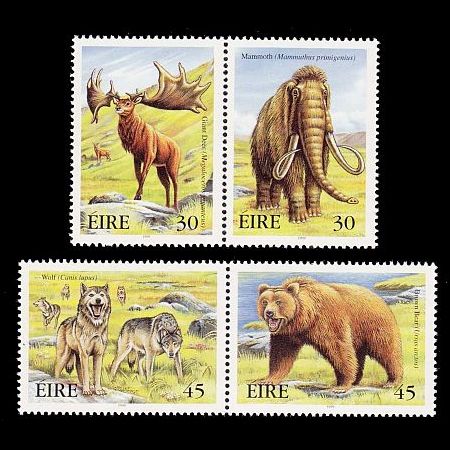
On October 11, 1999, the Post Authority of Ireland issued a set of four stamps "Extinct Irish Animals".
Following the Endangered Animals issue of 1998, stamp artist, Finbarr O'Connor has produced an equally exciting and colorful series of stamps featuring four animals which are now extinct in Ireland:
- the Wolf (Canis lupus)
- the Brown Bear (Ursus arctos)
- the Mammoth (Mammuthus primigenius)
- the Giant Irish Deer (Megaloceros giganteus)
The following text is based on the texts from the information card attached to FDC and the presentation pack, written by Erwin and Peggy Bauer from the National Museum of Ireland. Some notes were added by the author of this website.
In the distant past, the climate of Ireland was much colder, and its flora and fauna was very different to that which we see today. In the nineteenth century, giant bones belonging to a woolly mammoth (Mammuthus primigenius) were uncovered at Shandon Cave near Dungarvan. This long extinct animal roamed the southern part of Ireland about 27.000 years ago, during the Ice Age.
At that time, the British Isles were still joined to the European continent, by the Doggerland and stood on the edge of a fluctuating ice sheet which covered much of the northern hemisphere.
The landscape was of a type called wet tundra - open, treeless and studded with small lakes and ponds. It was still so cold that the hills were under snow, but on the lowlands, a flora of grasses, herbs and small shrubs attracted animals as varied as wild horses, spotted hyenas and reindeer.
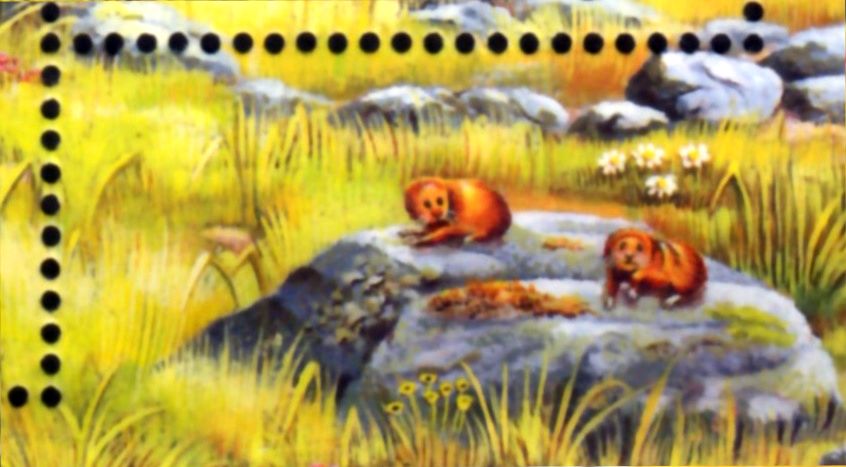 |
| Lemmings on margin of the Mini-Sheet of "Extinct Irish Animals" of Ireland 1999, |
Radiocarbon tests date these animal remains to between 26,000 and 32.000 years ago. A few of the animals of the ancient tundra are still native to Ireland, such as the red deer and the hare but the greater number of species will not be seen in Ireland's countryside. Some have become extinct everywhere, whilst others do not like Ireland present climate and habitat, or have been driven away by man.
Lemmings, for instance, are small mammals who now live near the arctic circle in Greenland and Scandinavia. During the pre-Midlandian stage, they established themselves in Ireland, and were still here 20.000 years ago when it was so cold that few other mammal species could survive. But as warmer conditions returned and the ice sheets and tundra receded, the lemmings retreated north.
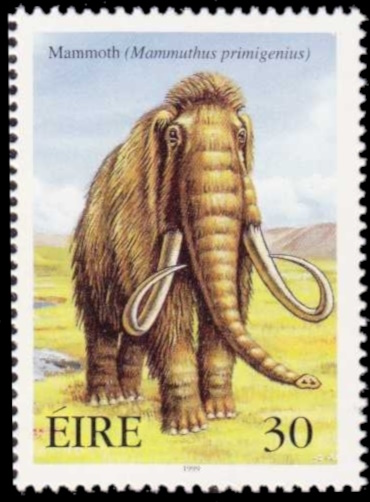 |
| Mammoth, Mammuthus primigenius, on gummed stamp of Ireland 1999, MiNr: 1184, Scott: 1205. |
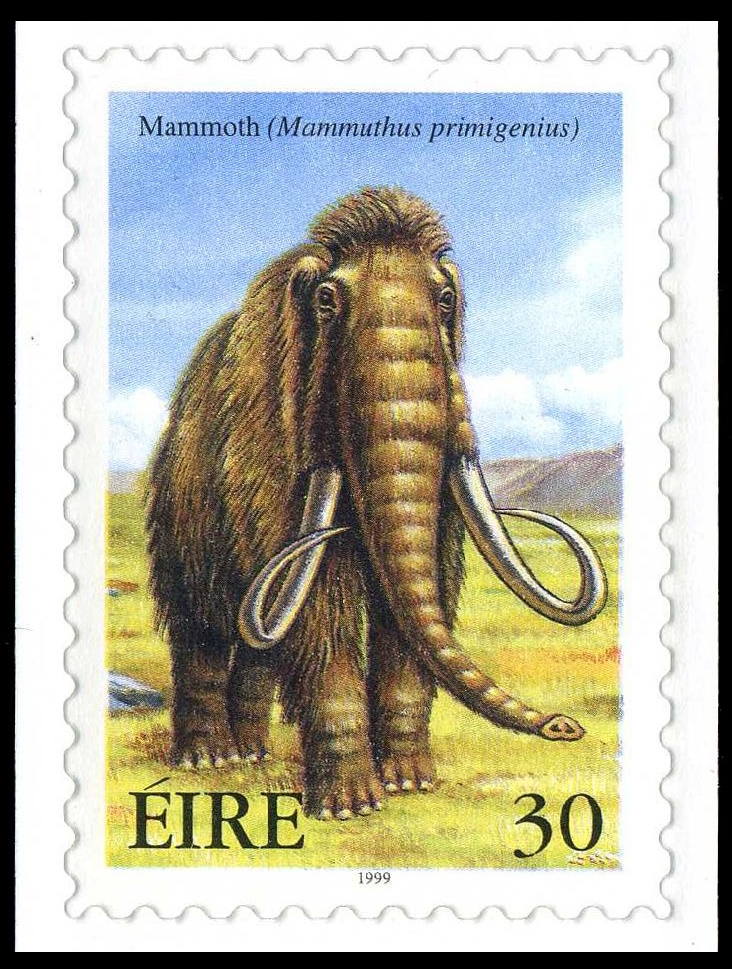 |
| Mammoth, Mammuthus primigenius, on self-adhesive stamp of Ireland 1999, MiNr: 1192, Scott: 1210. |
Fossilized bones, dated to around 33,000 years ago, confirm the presence of the woolly mammoth (Mammuthus primigenius) in Ireland around this time. The woolly mammoth was about the same size as a modern African elephant and had a thick two-layered coat of brown hair, to protect it from the intense cold.
After the last major cold phase of the Ice Age, about 20,000 years ago, mammoths became extinct here.
Even though mammoths became extinct at the end of the Ice Age, much has been learned about them from preserved specimens uncovered in the frozen tundra of Siberia.
There are also depictions of the animal in cave paintings and bone carvings made by early man in France, Spain, and Eastern Europe, for whom the mammoth was an important food source.
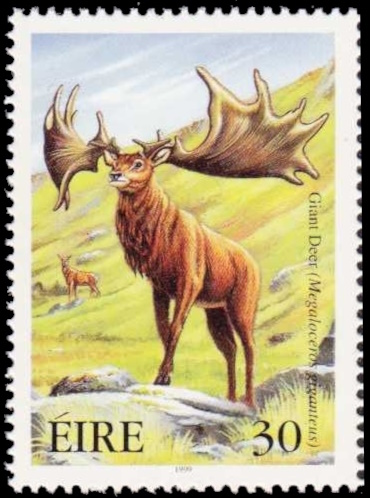 |
| Giant Irish Deer, Megaloceros giganteus, on gummed stamp of Ireland 1999, MiNr: 1185, Scott: 1206. |
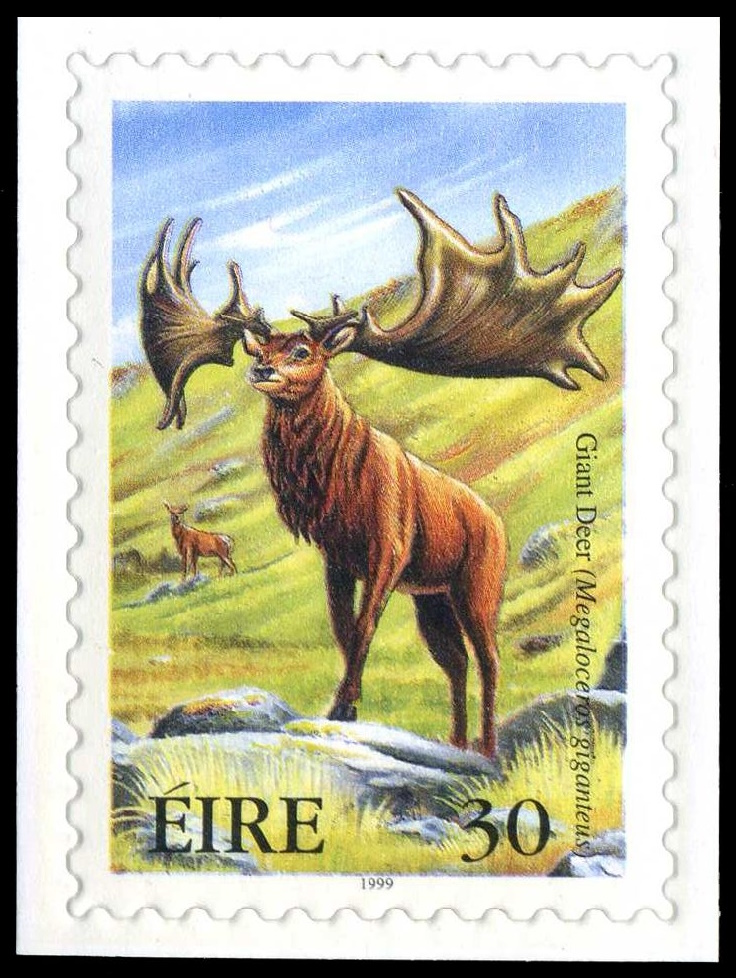 |
| Giant Irish Deer, Megaloceros giganteus, on self-adhesive stamp of Ireland 1999, MiNr: 1193, Scott: 1212. |
Giant deer are known to have been in Ireland at least 32,000 years ago, but the expansion of the ice sheets forced them to move further south. They returned about 12,000 years ago, when the lowland areas were again covered in rich grassland, and most surviving giant Irish deer bones and antlers date from this time.
Note: The animal is often called the Irish Deer or the Giant Irish Deer, however it is not unique to Ireland. Although the Giant Deer ranged from mainland Europe through Siberia to northern Africa, almost all the surviving skeletons and skulls were discovered in Ireland. This is due to the unique composition of Irish bogs. It seems the unfortunate top-heavy prehistoric animals regularly came to sticky ends mired in muddy lakes. The bog grew over them, fossilizing their remains, until they were uncovered by turf-cutters.
Ironically the first skeleton of "Irish Deer" discovered in Ireland in 1824 was only the second one. The very first one was discovered on Isle of Man five years earlier.
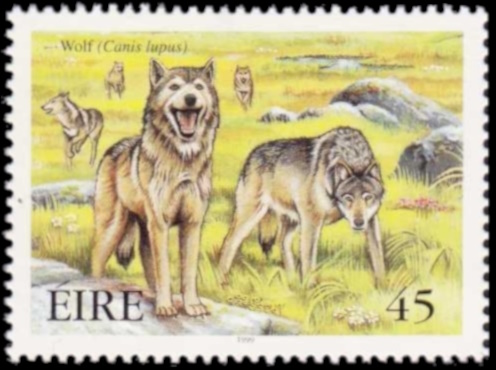 |
| Wolf, Canis lupus, on gummed stamp of Ireland 1999, MiNr: 1186, Scott: 1207. |
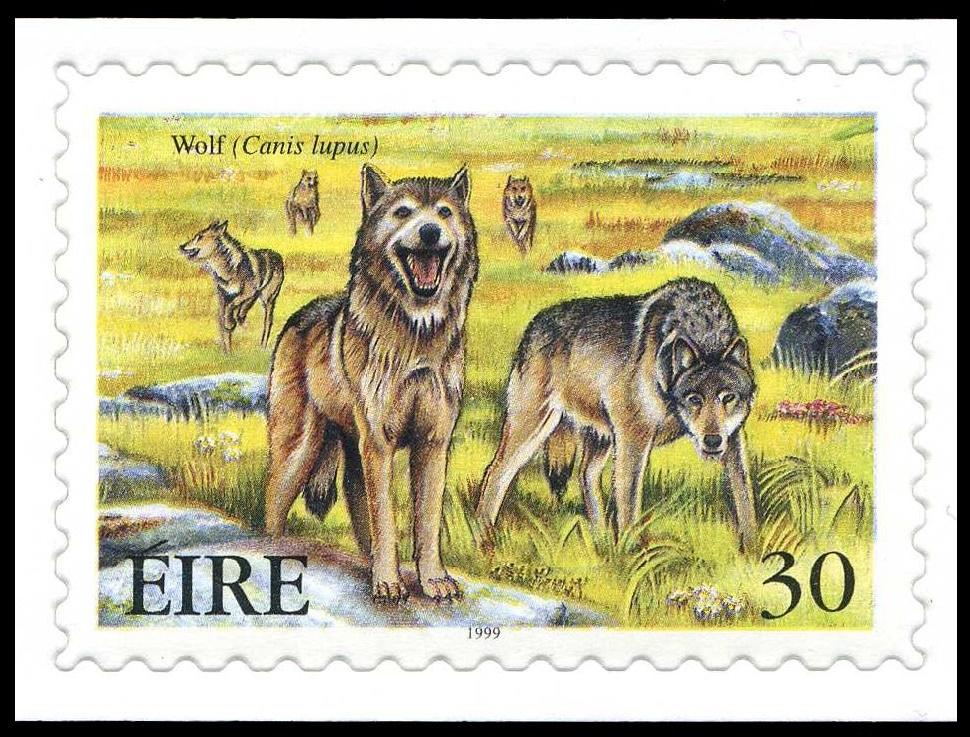 |
| Wolf, Canis lupus, on self-adhesive stamp of Ireland 1999, MiNr: 1194, Scott: 1211. |
The wolf is a predator, and at Castlepook Cave in Co. Cork, its bones were discovered alongside those of pre-Midlandian herbivores like reindeer and giant Irish deer. The animal is traditionally considered an enemy of mankind, but archaeologists in Southern Russia have found evidence that over 20,000 years ago, Stone Age hunters kept tame wolves in their camps. The species once abounded in the forests and mountains of Eurasia and North America, but is now confined to a few very remote or protected regions. The last known wolf in Ireland was killed about 300 years ago.
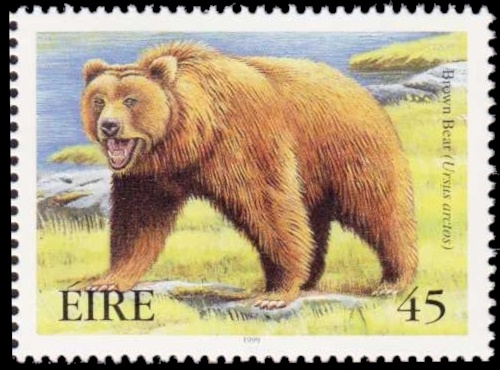 |
| Brown Bear, Ursus arctos, on gummed stamp of Ireland 1999, MiNr:1187, Scott: 1208. |
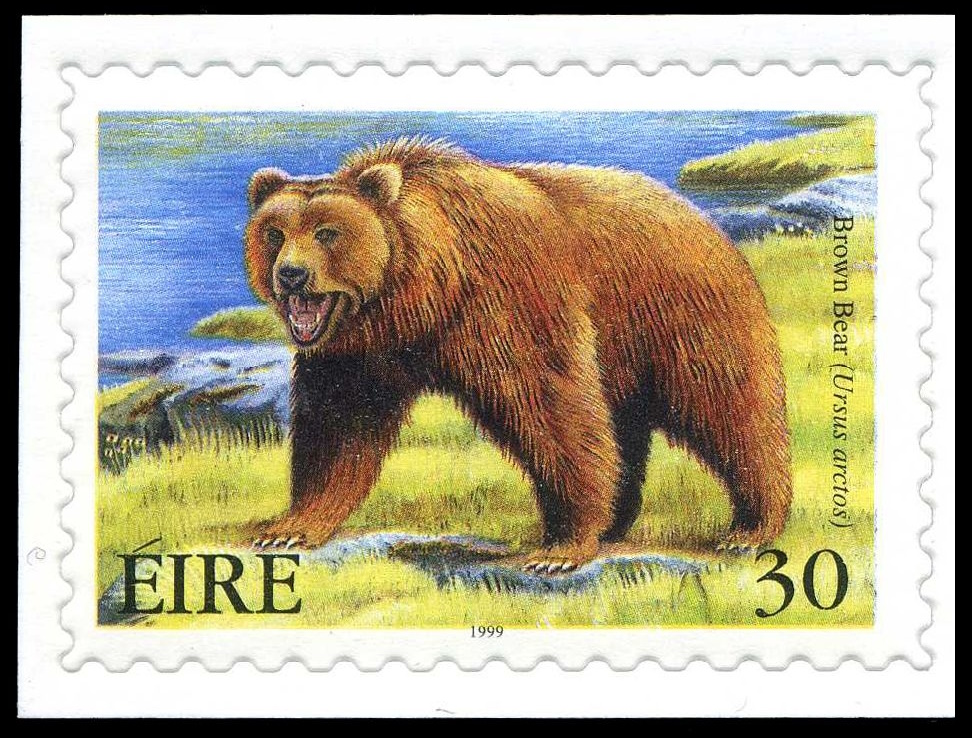 |
| Brown Bear, Ursus arctos, on self-adhesive stamp of Ireland 1999, MiNr: 1195, Scott: 1209. |
Products and associated philatelic items
| FDC with gummed stamps | FDC with self-adhesive stamps | |
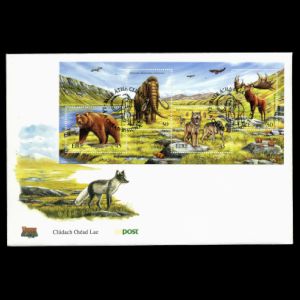 |
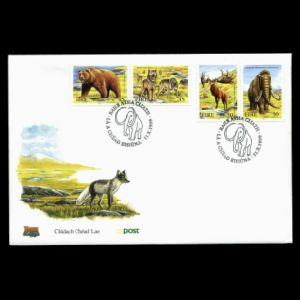 |
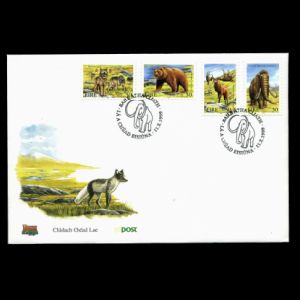 |
| The first day cover, which features the now extinct male arctic fox (Alopex lagopus) in summer coat, is also designed by Finbarr O'Connor. | ||
| Mini-Sheet | Sheets of gummed stamps | Self-adhesive stamps |
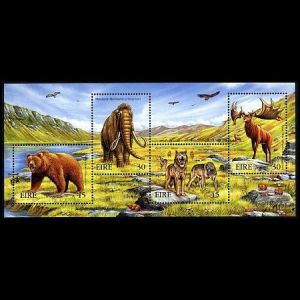 |
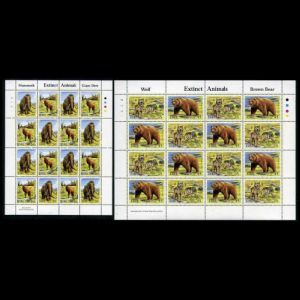 |
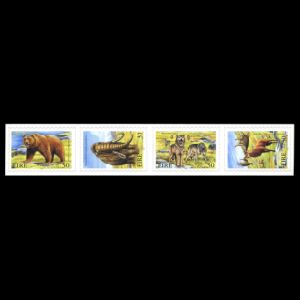 |
| First-Day-of-Issue Postmarks | Presentation Pack | |
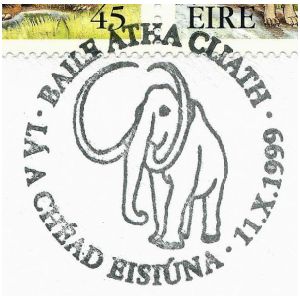 |
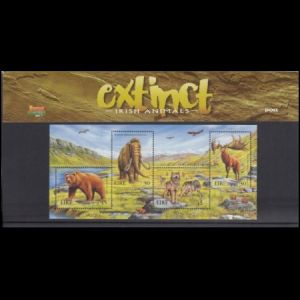 |
|
| The presentation pack is annotated on both the inside and outside with text about the animals depicted on the stamps. | ||

|
References
-
Technical details and short description:
- information card inside FDC
- Presentation Pack
- Colnect
- Discoveries of Woolly Mammoth (Mammuthus primigenius) in Ireland:
-
Discoveries of the Giant Irish Deer (Megaloceros giganteus) in Ireland:
- "150th Anniversary of the Natural History Museum"
- "THE MANX MUSEUM 1886-1986"
- "First discoveries Megaloceros giganteus", by Mr. Michael Kogan (the author of this website) and Dr. Peter Voice (the editor of this website)
Acknowledgements
Many thanks to Dr. Peter Voice from Department of Geological and Environmental Sciences, Western Michigan University, for review of a draft of this article and his valuable comments.| <prev | back to index | next> |